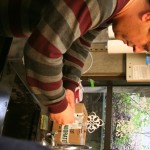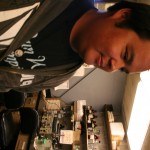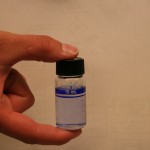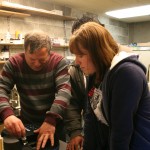Beam Reach and the Gato Verde had an excellent opportunity this term during the Beam Reach program. A film crew and a producer of the Show “Orca: The Sea Wolf†came aboard the Gato Verde to do some filming of the program and mainly Orcas and communication. Alexis, a producer from Pangolin Pictures, came aboard on May 27, 2009 around nine at night. She gave us release forms to sign and then she went to bed after a long day. Then in the morning Jeff, the cameraman, and his wife Kim came aboard. They started to film us releasing the boat, heading out, and our normal routine with getting updates on the whales. I got to make a phone call to Mark Mallison, a contact in Victoria, and have the entire conversation filmed. Then once we were out, Erica and Matt did some hydrophone deployment, got many shots of the Gato Verde, and us searching for the whales. It was a pretty cool day, and we all can’t wait until we get updates on the show and when it is going to air! We are going to be in a small portion on the Discovery Channel! That is so cool and we are super excited! It was a great experience to have because we got experience the world of entertainment of a bit and got a peak into what our futures are going to be like we ever get filmed again. Plus it was excellent advertisement for Scott, Beam Reach, and the Gato Verde! That is always a good thing! A new learning experience was gained with this experience and along with the many more from this program.
Read More
       Surfactants are used in our everyday life, whether we are washing our hands to our hair, cleaning dishes, or cleaning clothes. Surfactants play an important role in our everyday life as humans. Surfactants work by having a hydrophilic head, which loves water and a hydrophobic tail, which hates water. What makes it so useful is the fact that the hydrophobic tail will leech onto all the oil and grease we on household items and on ourselves. Then when each of the tails form a core that encloses an oil droplet, this is called a micelle. This makes both of each end of a surfactant happy. What is useful to humans is causing harm to fish and other inner tidal organism.
           Erica and I, as Beam Reach students in the spring 2009 term, have decided to measure the surfactants that the program releases into the ocean, while on the Gato Verde. With the help of Dr. Russel Barsh we have created a process of measuring each of the samples we have collected on the Gato Verde.
           This is our process for collecting each sample:
1.    Must be 48 hours before we run the test, if it sits to long the sample turns bad.
2.    Rinse syringe three times in sample test water
3.    Attach the filter to the syringe
4.    Filter out the sample and place into a clean container
5.    Place in the refrigerator to keep cool
Once we get back to the Friday Harbor Labs and meet Russel, here is the sample
testing process:
1.    Dilute the sample: 1mL of sample to 99mL of nano pure water.
2.    Scan the blank sample
3.    Add bicarbonate of soda to bring the pH up (used as a buffer)
4.    Add sodium chloride (salt) to bring up the density of the water.
5.    Add 2mL of methylene blue and toluene mix
6.    Mix for 1 minute to allow the formation of micelles
7.    Let it sit for 5 minutes
8.    Shoot the sample
9.    Read the Results
Our results with the four samples we have taken are:
1.    1st grey water sample: 1.7 ppm (2 gallons of water with 2 squirts of joy soap)
2.    2nd grey water sample: 5.5 ppm (4.5 gallons of water with 2.5 squirts joy soap)
3.    Roche Harbor: 0.3 ppm
4.    Mitchell Bay: 1.5 ppm
Most of these numbers are terrible, because 0.5 ppm is lethal to fish and inner
tidal organisms. Some of the effects are disrupting gas exchange across the gill, which clogs up oxygen exchange, and it suffocates the fish. It can also clog pours and disrupt membranes in crustacean causing the membrane to burst. If surfactants are doing damage to fish, how can that affect the SRKW? Our best option right now is to use less, but still find a efficient way to be clean! Remember the saying less is more.
Â
Best Wishes,
PeterÂ
Â
PS: Thank You Dr. Russel Barsh for helping us in the lab and informing us about surfactants and its effects!  Â
Â
Â
Â
Â
Â
Â
Â
Read More
Being in new places means meeting new people. Last weekend Hannah and I met some very interesting people who are members of Sea Shepherd. I had never heard of this group before we met them and it has been interesting reading about their history and some of the things they have done. This organization was established in 1977 as an international nonprofit marine wildlife conservation organization. Their mission is to end destruction of habitat and slaughter of wildlife in the world’s oceans. They have a very innovative direct action methodology in order to put a stop to killing of endangered marine species and ecosystems. They actually confront the offenders on high seas and have been known to sabotage ships and equipment. They have also been known to throw stink bombs onto the ships and in the past even ram into ships in order to disable them. The three main industries that Sea Shepherd targets are: the illegal whaling or killing of dolphins, the slaughtering of seals and the shark finning operations. Crewmembers are all volunteers and pay their own way to get to the ship for each mission but food and the stay on the boat is free. This organization has made many enemies and has been called eco terrorists by some governments. At the same time there have been many governments who have actually asked for their help with protecting patrol boats at times. They have raised a lot of awareness to issues that were not well known to the general public. They have also made a lot of political progress in stopping sealing in some European countries. The controversy lies in their sometimes violent methods. We have had some conversations about the organization, their methods, and their goals. Everyone has a different way of looking at it but we do all agree that they have done some good things and some not so good things. In the last year Animal Planet did a 7 show series titled Whale Wars. This show spread the word to the general public that whaling still occurs today and is not just a thing of the past. Although their sometimes violent methods are frowned upon they have made the public more aware of many issues in our marine ecosystems that need to be addressed.

Read More
The footage taken by Brett Becker and Courtney Kneipp back in 2005 keeps adding value to the community of orca advocates and scientists. It was heartening to hear the fundraiser participants ooh and ah at the simultaneous “logging” behavior of J and L pod members, as well as the synchronous chorus of calls that occurs suddenly in the last 30 seconds of the video.
If you enjoy the video, don’t hesitate to make a donation to The Whale Museum this spring. They could use some help to keep Soundwatch on the water continuously this summer…
|
More than 150 avid supporters turned out at Mullis Community Senior Center Saturday night for The Whale Museum’s third annual Celebration of the Orca Greeting Ceremony. By the end of the evening, the museum had raised more than $16,000 to support its education and research projects.
|
| The popular event, which features a gourmet dinner, raffle, and silent and live auctions, was inspired by an orca greeting ceremony documented in the waters off of Hannah Heights on Oct. 4, 2004, by Dr. Scott Veirs and a group of BeamReach students. |
| Auctioneer Eugene Cuomo cajoled and coaxed the enthusiastic crowd into raising their fluke-shaped bidding paddles for such treats as Leslie Veirs’ “Scrumptious Ice Cream Torte†($375) |
|
|
Read More
Prevost to Mitchell
5/13/09
We woke to a rainy, gray morning in Prevost Harbor. We desperately needed to pump out so we went to Roche Harbor first thing and held our morning meeting on the way. We spent the morning discussing Hannah’s journal club article and headed to the Lime Kiln area, hoping to catch the whales while we satisfied our other science goals. We were finally able to record some ship data for my project but we were eventually driven north towards Mitchell Bay and shelter by bad conditions. Before entering Mitchell Bay, we took a conductivity, salinity and temperature cast and also practiced vertical plankton tows. We took a quick reading of the water clarity using a Secci desk and then proceeded into Mitchell Bay at about 6:15. Scott and Jason made amazing minestrone soup, cornbread and salad for dinner and we settled in for a quiet evening, fending off the wet and cold.
Read More
Sucia to Stuart
5/12/09
We first started off the day excited to see whales. We kept in contact with Ivan, Jim, and Mark in order to work as a team to find the whales. The whales were spoted on the south end of the San Juan Islands and heading towards south of Discovery island. The big problem was we were way up north and it was going to take us three hours to get to the middle of Haro Strait. DUring our long journey we played with the fish cam, sailed, and Scott gave us a lecture on Temperature and Salinity Oceanography. Then it was a battle with the waves! As we went further south, the waves got higher as we began to feel sick. WE all kept it together in the name of science! Once we were down south, we got a message on the radio by Jim that the SRKW were being heard on Orca sound! It was time to head north and find the whales! We saw lots of boat action as we got closer to Stuart, and saw lots of the vapors from their blow holes! WE kept tracking them, but failed because they were head up to the Swanson Channel, in Canadian territory! We failed and had to turn around and try tommorrow. We were defeated today, but there is always tommorow! The Beam Pod is ready for another day of SCIENCE!
Read More
Jones Island north – FHL
5/3/09
Today we went back to Friday Harbor Labs for our week on land. Gato Verde got a deep clean and we are halfway done with the program!!
Now it’s time to work on those proposals!
View Larger Map
Read More
Over the course of this program, I’ve heard the understanding of whale calls and language compared to the Rosetta Stone and the Holy Grail. Given the amount of effort, speculation and near worship given to both of these, I’m beginning to think they are right.
My project does not attempt to understand the meaning of whale calls in any sense but the tiny portion I am examining makes me realize just how impossible that task would be. People have attempted it, continue to attempt it, approaching it from every possible angle to try to understand what whales are saying but their language and so many other aspects of them continue to elude us.

J1, traveling North up Kellett Bluff
Jason was the first person I heard refer to the whales as “charismatic mega fauna.†I don’t know if that’s a common way to refer to killer whales because I’ve now heard Todd and Val refer to them that way as well but the name makes me think about how popular these animals are when all you mostly ever see of them in the wild is a black dorsal fin.
Hannah calls them “sea ninjas†because they are so sneaky and suited to their environment. On many days, we’ve been out looking for them in Haro Strait, six pairs of eyes behind binoculars, straining to see them only to hear on the radio that they’d gone clean past us with no one the wiser. It’s not as if these are small creatures or that they blend in. They’re giant whales with black and white bodies. You’d think they’d stick out like sore thumbs but they don’t.
Killer whales are mysterious, fascinating creatures but the most surprising thing about them to me is how many people they have managed to enthrall. Killer whales are an icon, a demonstration of the mystery of the sea and of the strength and grace of its creatures. They are a rallying point for conservationists everywhere, a fascination for people from all walks of life. They live in every ocean of the world, with different hunting strategies, languages, food sources and behaviors. Actually when I think about it, it seems like it should be more surprising to me that they haven’t fascinated more people.
And yet we know so little about them. We know so little about the ocean as a whole. While I respect and admire the whales immensely, I wish we could all pull back the focus a little bit more to take in the whole picture. Because of their charismatic, mysterious nature, killer whales pull our attention towards them and yet they are not the whole picture. As an apex predator, their condition is a strong indicator of the health of their ecosystem. While the whales themselves need focus and attention, we need to remember that they are only a small part of an enormous ecosystem, a huge web which trembles with every tiny shift in a great balance.
In every ecosystem, scientists and researchers focus on individual species and on relationships. I think both parts are key but a balance is necessary. In order to know enough about a species, you must know a great deal about how it interacts with all components of its world and the effects that it has. I wish it were easier to strike that balance.
Read More
Living on a boat with eight people is an interesting experience. It is fun but it definitely has its challenges. One of those challenges is food. Cooking on a boat is challenging, especially if the seas are very active. Our rations have come from NOLS. They are an educational organization with many different outdoor programs. They ration food for their programs based on the calories needed per day per person, instead of designing meals for each day. These calories are broken down using the food pyramid so that the participants have enough carbs, proteins, sugar and other nutrients. Their method of rationing is really helpful because everyone gets the nutrition and calories they need while allowing for flexibility of the meals. The only food we aren’t getting from NOLS is fresh fruits and vegetables. The food from NOLS is all dried or dehydrated material that is pretty easy to cook. We were able to go to NOLS in Mount Vernon at the beginning of the quarter and bag all of our food for the five weeks on the boat. Everything was calculated by pounds and then divided by week.
We have the NOLS cookbook onboard with an assortment of meals that we can make. Our galley on the boat consists of two stove top burners and an oven that is capable of broiling. These are all fueled by propane. We are now more than halfway done with our time at sea and the food has turned out to be a fun and complicated experience. We have tried many different meals. One of our challenges is satisfying everyone’s preference. Everyone on the boat likes and dislikes different things. I don’t like onions which is a common ingredient in a lot of soups and other meals. Hannah is not a fan of pasta and loves vegetables. Hilary doesn’t eat eggs or potatoes. It is difficult to plan meals to satisfy everyone but we have managed to work through it. Luckily, we are all willing to try and stay away from the things others don’t like for the most part. There are times when we just need to make pasta because we have a lot of it but we make a lot of veggies with it as well. One mornings when we have eggs and hash browns Hilary just eats granola or a bagel, and when onions are used in soup or something else the cooks cut them large enough so that I can pick them out easily or they are just on the side so that whoever wants them can add them.
http://www.nols.edu/store/home.php


Read More

Beam Reach Bulletin Board
A primary goal of Beam Reach is to continually learn new aspects of the killer whale and share that knowledge with the community. The knowledge gained through the program is expected to create awareness in the Salish Sea, but has spread all the way to Delaware, OH.
Mrs. Williams’ third grade class at Carlisle Elementary has been in correspondence with Beam Reach via letters and phone calls. They are currently in their animal unit in science class, and every student in the class wrote a letter with their questions about orcas and the requirements of being a scientist.
I wrote back trying to answer all of their questions. A lot of the interests of the students involved the different kinds of animals seen during the Beam Reach program. Since the animals in the Salish Sea are not native to Ohio, the students spent time researching and learning about the organisms.

Mrs. Williams' 3rd Grade Class
I think the interaction between students of Mrs. Williams’ class and the Beam Reach students has been beneficial for both parties. It is important to remember that the information we learn in Beam Reach is meant to be shared with the public. If we do not communicate our findings, all of the hard we put in to studying the orcas will not be able benefit the killer whale population.
Read More














 Twitter
Twitter LinkedIn
LinkedIn Facebook
Facebook